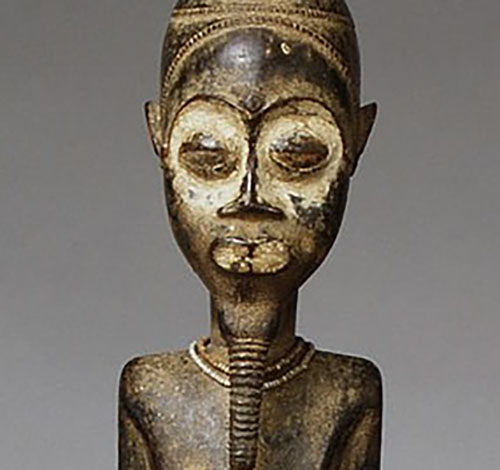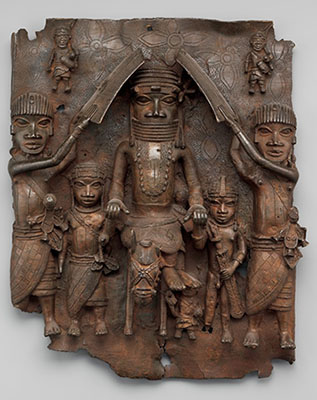Chapter 12.5: Visual Expression
Because many tradition-based African artifacts serve a specific function, Westerners have sometimes not regarded them as art. We need to recognize, however, that the concept of “art for art’s sake” is a relatively recent invention of the Western world. Prior to the Renaissance, most art traditions around the world were considered functional as well as aesthetic. The objects African artists create, while useful, also embody aesthetic preferences and may be admired for their form and composition.
Aesthetics
Artists and patrons in many African societies express well-defined aesthetic preferences and value skillful work. Studies of aesthetics in some African societies have led to the identification of certain artistic criteria for evaluating visual arts. Among the Baule in Côte d’Ivoire, for example, a sculpture of the human figure should emphasize a strong muscular body, refined facial features, and elaborate hairstyle and scarification patterns, all of which reflect cultural ideals of civilized beauty (above and detail left). Scholars of aesthetics in Yoruba (Nigeria) visual expression have identified criteria based on both formal elements, such as a smooth surface, symmetrical composition, and a moderate resemblance to the subject, as well as abstract cultural concepts, such as ase (inner power or life force) and iwa (character or essential nature). Many African societies associate such smooth, finished surfaces with cultivated refinement.


African aesthetics generally have an ethical or religious basis. An artwork considered “beautiful” is often also believed to be “good,” in the sense that it exemplifies and upholds moral values. The fact that, in many societies, the words for beautiful and good are the same suggests a strong correspondence between these two ideas. The ability of an artifact to work effectively, whether that means connecting with the spiritual realm or imparting a lesson to initiates, may also be a standard for determining the “beauty” of an artifact.
Although in the Western world, aesthetics is often equated with beauty, artists in some African cultures create works that are not intended to be beautiful. Such works are deliberately horrific in order to convey their fearsome powers and thereby elicit a strong reaction in the viewer (above).
The Human Figure, Animals, and Symbols

The human figure is the main subject that traditionally has engaged African artists. African figurative sculpture usually departs from natural proportions. There is often a conceptual basis behind artistic conventions, such as the simplification and exaggeration of human features. For example, in many African artworks, the head appears proportionately larger than the body. This formal emphasis has symbolic meaning, as the head is believed to have a special role in guiding one’s destiny and success in many African societies. African artists also employ scale for symbolic effect in multi-figure compositions, a practice known as hierarchical representation. In these cases, the most important individual is depicted as the largest figure, while those of lesser importance decrease in size exponentially (right).
Animals and the Natural World
Animals with special attributes—such as antelopes, snakes, leopards, and crocodiles—are represented in art for symbolic purposes. For example, the nineteenth-century Fon king Guezo is represented by a buffalo, an animal signifying strength and determination, selected as his emblem through fa divination (below). Representations of animals consuming other animals (below) may serve as a metaphor for competing spiritual or social forces. Their depiction is meant to encourage other, less destructive means to resolve a difficult social encounter. Features of different types of animals may also be combined into new forms that synthesize complex ideas. Among the Bamana, for example, ci wara headdresses are based on the features of various antelope species and may also incorporate those of aardvarks, anteaters, and pangolins, all highly symbolic animals. The resulting synthesis of animal forms evokes the mythic Ci Wara, the divine force conceptualized as half man and half antelope who introduced agricultural methods to the Bamana. Animal symbols may also take more abstract form. In the Cameroon Grassfields, circular medallions represent spiders, a symbol of supernatural wisdom, and diamond-shaped motifs refer to frogs, which stand for fertility and increase. Some forms of symbolism in African art use plants as points of reference. On cast plaques from Benin, a background pattern of river leaves is a symbol for Olokun, god of the sea (below).
Other Forms of Symbolism
Symbols may be nonrepresentational. Geometric patterns on Bwa plank masks have multiple levels of meaning that refer to ideals of social and moral behavior taught to initiates. Materials also hold symbolic value. Gold foil used in Asante regalia alludes to the sun and to life’s vital force. Indigenous forms of writing, such as nsibidi used among various cultures in Nigeria’s Cross River region, embody multiple levels of symbolic meaning that can be accessed only by the initiated. Gestures, too, are a form of symbolism (see the example left) where painted designs on the forehead and cheeks of the faces represent nsibidi, an indigenous writing).
In Kongo art, a seated pose illustrates a dictum about balance, composure, and reflection (example, below), while a protruding tongue refers indirectly to the activation of medicines.
Form and Meaning
Abstraction and Idealization
Realism or physical resemblance is generally not the goal of the African artist. Many forms of African art are characterized by their visual abstraction, or departure from representational accuracy. Artists interpret human or animal forms creatively through innovative form and composition. The degree of abstraction can range from idealized naturalism, as in the cast brass heads of Benin kings, to more simplified, geometrically conceived forms, as in the Baga headdress.
The decision to create abstract representations is a conscious one, evidenced by the technical ability of African artists to create naturalistic art, as seen, for example, in the art of Ife, in present-day Nigeria. Idealization is frequently seen in representations of human beings. Individuals are almost always depicted in the prime of life, never in old age or poor health. Culturally accepted standards of moral character and physical beauty are expressed through formal emphasis. Masks used by the women’s Sande society, for example, present Mende cultural ideals of female beauty. Instead of a physical likeness, the artist highlights admired features, such as narrow eyes, a small mouth, carefully braided hair, and a ringed neck. Idealized images often relate to expected social roles and emphasize distinctions between male and female. In Bamana statuary, full breasts and a swelling belly highlight a woman’s role as nurturer.
At the same time, complementary male and female pairs of figures express the concept of an ideal social unit through matched gestures, stances, and expressions.
Media Attributions
- Figure 1. Baule Peoples, Diviner’s Figure, 19th-20th century, Wood, pigment, beads, iron. (The Metropolitan Museum of Art). Baule diviners are consulted by people who desire assistance in solving significant problems, perhaps relating to childbearing or other health concerns. Sculptures are often an important presence in divining sessions (Image source: The Metropolitan Museum of Art via Artstor. Used with permission, for education use only)
- Figure 2. Close up of the male Baule Peoples, Diviner’s Figure (Image source: The Metropolitan Museum of Art via Artstor. Used with permission, for education use only)
- Figure 3. Edo Peoples, Plaque: Equestrian Oba and Attendants, 1550-1680, Nigeria, Court of Benin, brass (Image source: The Metropolitan Museum of Art via Artstor. Used with permission, for education use only)
Candela Citations
- Aesthetics and African art. Authored by: Dr. Christa Clarke. Provided by: Smarthistory. Retrieved from: https://smarthistory.org/aesthetics/. License: CC BY-NC-SA: Attribution-NonCommercial-ShareAlike

